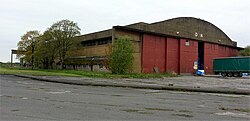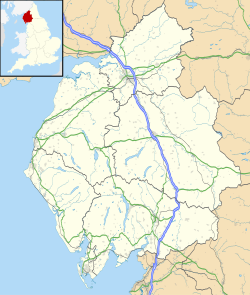RAF Kirkbride
| RAF Kirkbride | |||||||||||
|---|---|---|---|---|---|---|---|---|---|---|---|
| Kirkbride, Cumbria in England | |||||||||||
 Hangar RAF Kirkbride | |||||||||||
| Coordinates | 54°52′55″N 3°12′14″W / 54.882°N 3.204°W | ||||||||||
| Grid reference | NY228548 | ||||||||||
| Type | Airfield | ||||||||||
| Site information | |||||||||||
| Owner | Air Ministry | ||||||||||
| Operator | RAF | ||||||||||
| Controlled by | Maintenance Command | ||||||||||
| Open to the public | Yes | ||||||||||
| Site history | |||||||||||
| Built | 1938–1939 | ||||||||||
| In use | 1939–1960 | ||||||||||
| Fate | Disposed of; private ownership | ||||||||||
| Airfield information | |||||||||||
| Identifiers | ICAO: EGZF | ||||||||||
| |||||||||||
RAF Kirkbride, was a World War Two era airfield in the village of Kirkbride, Cumbria, England. Opened in June 1939, the base was intended to be an aircraft repair depot, as its location was deemed to be far enough away from the threat of enemy fighters and bombers. After the Second World War, the site remained open as a Maintenance Unit and a disposal airfield for redundant aircraft. It was closed in 1960.
History
In the planning stage, the airfield was intended to be an ASU (aircraft storage unit), rather than and ARD (aircraft repair depot), which is what it became with the work of No. 12 MU.[2] The station was provided with 15 hangars at the outset; one x type-C, four x type-D, six x type-E, and four x type-L.[3] Historic England states that at the closure of the base in 1960, the site had 38 hangars.[4] Most of the pilots operating out of the base were part of the Air Transport Auxiliary; one of whom described a particularly clever attack a by a Luftwaffe pilot flying a Messerschmitt 110, which looked like a Hampden. The aircraft lowered its landing gear and waggled its wings to mimic the procures used by ATA pilots when they coming in to land. The bomber then applied thrust and strafed the base dropping at least three bombs on Kirkbride.[5]
No. 12 Maintenance Unit remained at the base for the duration of Kirkbride's RAF existence. 12 MU's motto was Nunquam intermittere cursum (Template:Lang-la).[6]
An inquiry during a session of Parliament in 1958, revealed that during the 1955–1956 financial year, over £100,000 (equivalent to £3,152,618 in 2023) was spent on repairing aircraft at the base.[7]
Post closure
The RAF abandoned the site in 1960, but it was considered as a possible ground station for the American MIDAS system, though in the eventuality, it was never used.[8] The plan was that it would remain under RAF control, initially stated to be part of Fighter Command, and furnished with three radomes each about 100 feet (30 m) in diameter, (similar to the initial equipment at RAF Fylingdales).[9]
The site is part of the Solway Military Trail, which details access to parts of the site via existing footpaths.[10] The former officers mess building has been converted into a hotel, and most of the hangars are now used for agricultural purposes.[11]
Notes
References
- ^ "Site/Airfield Details | NOTAM Info". notaminfo.com. Retrieved 29 August 2022.
- ^ The Royal Air force builds for war : a history of design and construction in the RAF, 1935-1945. London: Stationery Office. 1997 [1956]. p. 68. ISBN 0117724696.
- ^ Delve 2006, p. 157.
- ^ "Kirkbride Airfield". www.heritagegateway.org.uk. Retrieved 29 August 2022.
- ^ Schrader, Helena (2006). Sisters in arms. Barnsley: Pen & Sword Aviation. p. 127. ISBN 1844153886.
- ^ Pine, L G (1983). A dictionary of mottoes. London: Routledge and Kegan Paul. p. 159. ISBN 0-7100-9339-X.
- ^ "No. 12 Maintenance Unit, Kirkbride (Hansard, 16 July 1958)". api.parliament.uk. Retrieved 15 August 2022.
- ^ Stocker, Jeremy (2004). Britain and ballistic missile defence, 1942-2002. London: Frank Cass. p. 104. ISBN 0714656968.
- ^ "British Midas Station Will Give Six-Minute Warning". The Times. No. 55138. 20 July 1961. p. 9. ISSN 0140-0460.
- ^ "RAF Kirkbride". Solway Military Trail. Retrieved 15 August 2022.
- ^ "Forgotten airfields europe". www.forgottenairfields.com. Retrieved 15 August 2022.
Sources
- Delve, Ken (2006). Northern England : Co. Durham, Cumbria, Isle of Man, Lancashire, Merseyside, Manchester, Northumberland, Tyne & Wear, Yorkshire. Ramsbury: Crowood. ISBN 1-86126-809-2.

